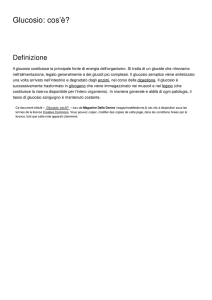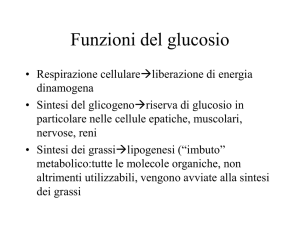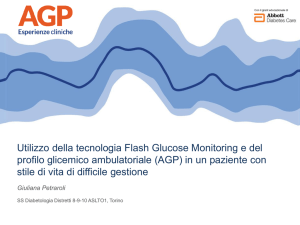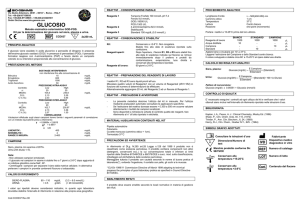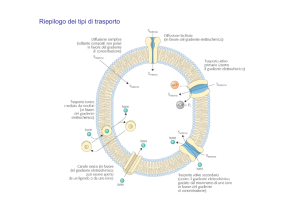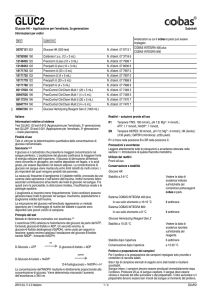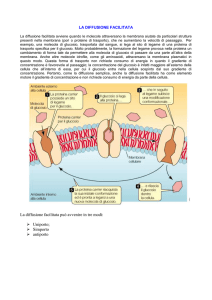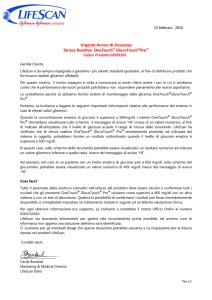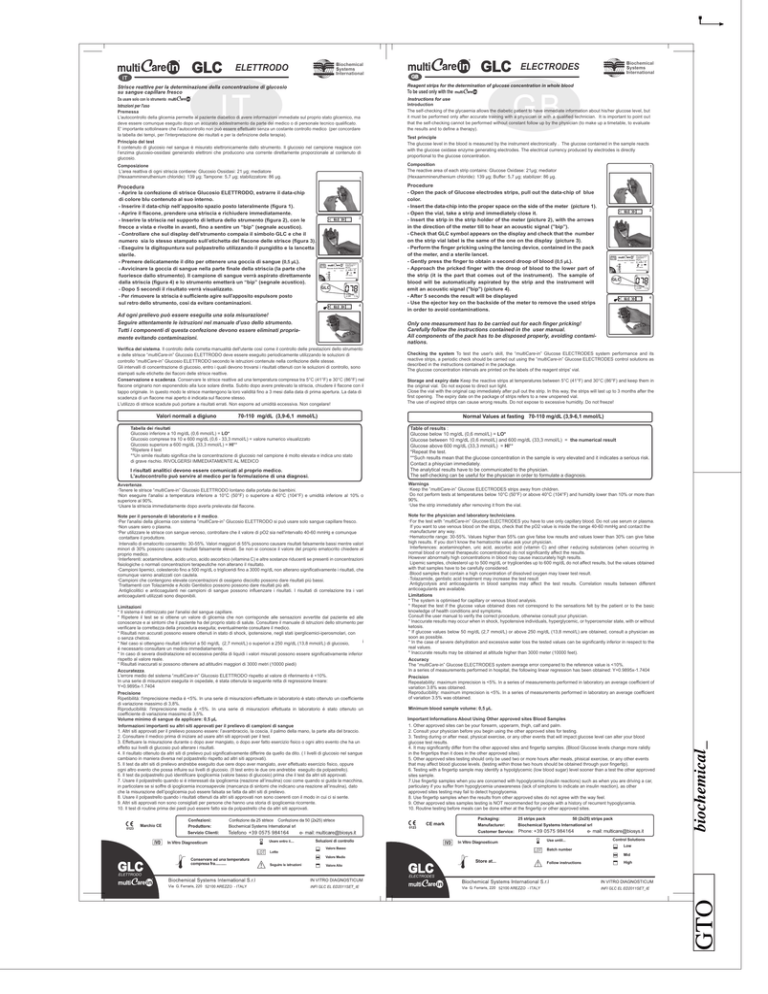
Biochemical
Systems
International
ELETTRODO
IT
GB
Reagent strips for the determination of glucose concentration in whole blood
Premessa
L'autocontrollo della glicemia permette al paziente diabetico di avere informazioni immediate sul proprio stato glicemico, ma
deve essere comunque eseguito dopo un accurato addestramento da parte del medico o di personale tecnico qualificato.
E' importante sottolineare che l'autocontrollo non può essere effettuato senza un costante controllo medico (per concordare
la tabella dei tempi, per l'interpretazione dei risultati e per la definizione della terapia).
GB
Instructions for use
Introduction
The self-checking of the glycaemia allows the diabetic patient to have immediate information about his/her glucose level, but
it must be performed only after accurate training with a physician or with a qualified technician. It is important to point out
that the self-checking cannot be performed without constant follow up by the physician (to make up a timetable, to evaluate
the results and to define a therapy).
Principio del test
Il contenuto di glucosio nel sangue è misurato elettronicamente dallo strumento. Il glucosio nel campione reagisce con
l’enzima glucosio-ossidasi generando elettroni che producono una corrente direttamente proporzionale al contenuto di
glucosio.
Test principle
The glucose level in the blood is measured by the instrument electronically . The glucose contained in the sample reacts
with the glucose oxidase enzyme generating electrodes. The electrical currency produced by electrodes is directly
proportional to the glucose concentration.
Composizione
L'area reattiva di ogni striscia contiene: Glucosio Ossidasi: 21 µg; mediatore
(Hexaammineruthenium chloride): 139 µg; Tampone: 5,7 µg; stabilizzatore: 86 µg.
Composition
The reactive area of each strip contains: Glucose Oxidase: 21μg; mediator
(Hexaammineruthenium chloride): 139 μg; Buffer: 5,7 μg; stabilizer: 86 μg.
Procedura
Procedure
- Open the pack of Glucose electrodes strips, pull out the data-chip of blue
color.
- Insert the data-chip into the proper space on the side of the meter (picture 1).
- Open the vial, take a strip and immediately close it.
- Insert the strip in the strip holder of the meter (picture 2), with the arrows
in the direction of the meter till to hear an acoustic signal (”bip”).
- Check that GLC symbol appears on the display and check that the number
on the strip vial label is the same of the one on the display (picture 3).
- Perform the finger pricking using the lancing device, contained in the pack
of the meter, and a sterile lancet.
- Gently press the finger to obtain a second droop of blood (0,5 µL).
- Approach the pricked finger with the droop of blood to the lower part of
the strip (it is the part that comes out of the instrument). The sample of
blood will be automatically aspirated by the strip and the instrument will
emit an acoustic signal ("bip") (picture 4).
- After 5 seconds the result will be displayed
- Use the ejector key on the backside of the meter to remove the used strips
in order to avoid contaminations.
- Aprire la confezione di strisce Glucosio ELETTRODO, estrarre il data-chip
di colore blu contenuto al suo interno.
- Inserire il data-chip nell’apposito spazio posto lateralmente (figura 1).
- Aprire il flacone, prendere una striscia e richiudere immediatamente.
- Inserire la striscia nel supporto di lettura dello strumento (figura 2), con le
frecce a vista e rivolte in avanti, fino a sentire un “bip” (segnale acustico).
- Controllare che sul display dell’strumento compaia il simbolo GLC e che il
numero sia lo stesso stampato sull’etichetta del flacone delle strisce (figura 3).
- Eseguire la digitopuntura sul polpastrello utilizzando il pungidito e la lancetta
sterile.
- Premere delicatamente il dito per ottenere una goccia di sangue (0,5 µL).
- Avvicinare la goccia di sangue nella parte finale della striscia (la parte che
fuoriesce dallo strumento). Il campione di sangue verrà aspirato direttamente
dalla striscia (figura 4) e lo strumento emetterà un “bip” (segnale acustico).
- Dopo 5 secondi il risultato verrà visualizzato.
- Per rimuovere la striscia è sufficiente agire sull'apposito espulsore posto
sul retro dello strumento, così da evitare contaminazioni.
078
Glucose ELECTRODES
25
GLC
Ad ogni prelievo può essere eseguita una sola misurazione!
Seguire attentamente le istruzioni nel manuale d’uso dello strumento.
Tutti i componenti di questa confezione devono essere eliminati propriamente evitando contaminazioni.
Verifica del sistema. Il controllo della corretta manualità dell'utente così come il controllo delle prestazioni dello strumento
e delle strisce “multiCare-in” Glucosio ELETTRODO deve essere eseguito periodicamente utilizzando le soluzioni di
controllo “multiCare-in” Glucosio ELETTRODO secondo le istruzioni contenute nella confezione delle stesse.
Gli intervalli di concentrazione di glucosio, entro i quali devono trovarsi i risultati ottenuti con le soluzioni di controllo, sono
stampati sulle etichette dei flaconi delle strisce reattive.
Conservazione e scadenza. Conservare le strisce reattive ad una temperatura compresa tra 5°C (41°F) e 30°C (86°F) nel
flacone originario non esponendolo alla luce solare diretta. Subito dopo avere prelevato la striscia, chiudere il flacone con il
tappo originale. In questo modo le strisce mantengono la loro validità fino a 3 mesi dalla data di prima apertura. La data di
scadenza di un flacone mai aperto è indicata sul flacone stesso.
L'utilizzo di strisce scadute può portare a risultati errati. Non esporre ad umidità eccessiva. Non congelare!
Valori normali a digiuno
Avvertenze.
.Tenere le strisce “multiCare-in” Glucosio ELETTRODO lontano dalla portata dei bambini.
.Non eseguire l'analisi a temperatura inferiore a 10°C (50°F) o superiore a 40°C (104°F) e umidità inferiore al 10% o
superiore al 90%.
.Usare la striscia immediatamente dopo averla prelevata dal flacone.
Note per il personale di laboratorio e il medico.
.Per l'analisi della glicemia con sistema “multiCare-in” Glucosio ELETTRODO si può usare solo sangue capillare fresco.
.Non usare siero o plasma.
.Per utilizzare le strisce con sangue venoso, controllare che il valore di pO2 sia nell'intervallo 40-60 mmHg e comunque
contattare il produttore.
Intervallo di ematocrito consentito: 30-55%. Valori maggiori di 55% possono causare risultati falsamente bassi mentre valori
.minori di 30% possono causare risultati falsamente elevati. Se non si conosce il valore del proprio ematocrito chiedere al
proprio medico.
.Interferenti: acetaminofene, acido urico, acido ascorbico (vitamina C) e altre sostanze riducenti se presenti in concentrazioni
fisiologiche o normali concentrazioni terapeutiche non alterano il risultato.
.Campioni lipemici, colesterolo fino a 500 mg/dL o trigliceridi fino a 3000 mg/dL non alterano significativamente i risultati, che
.
comunque
vanno analizzati con cautela.
.Campioni che contengono elevate concentrazioni di ossigeno disciolto possono dare risultati più bassi.
Trattamenti con Tolazamide e Acido Gentistico possono possono dare risultati più alti.
Antiglicolitici e anticoagulanti nei campioni di sangue possono influenzare i risultati. I risultati di correlazione tra i vari
anticoagulanti utilizzati sono disponibili.
Limitazioni
* Il sistema è ottimizzato per l'analisi del sangue capillare.
* Ripetere il test se si ottiene un valore di glicemia che non corrisponde alle sensazioni avvertite dal paziente ed alle
conoscenze e ai sintomi che il paziente ha del proprio stato di salute. Consultare il manuale di istruzioni dello strumento per
verificare la correttezza della procedura eseguita; eventualmente consultare il medico.
* Risultati non accurati possono essere ottenuti in stato di shock, ipotensione, negli stati iperglicemici-iperosmolari, con
o senza chetosi.
i
* Nel caso si ottengano risultati inferiori a 50 mg/dL (2,7 mmol/L) o superiori a 250 mg/dL (13,8 mmol/L) di glucosio,
è necessario consultare un medico immediatamente.
* In caso di severa disidratazione ed eccessiva perdita di liquidi i valori misurati possono essere significativamente inferior
rispetto al valore reale.
* Risultati inaccurati si possono ottenere ad altitudini maggiori di 3000 metri (10000 piedi)
Accuratezza.
L'errore medio del sistema “multiCare-in” Glucosio ELETTRODO rispetto al valore di riferimento è <10%.
In una serie di misurazioni eseguita in ospedale, è stata ottenuta la seguente retta di regressione lineare:
Y=0.9895x-1.7404
Precisione
Ripetibilità: l'imprecisione media è <5%. In una serie di misurazioni effettuate in laboratorio è stato ottenuto un coefficiente
di variazione massimo di 3,8%.
Riproducibilità: l'imprecisione media è <5%. In una serie di misurazioni effettuata in laboratorio è stato ottenuto un
coefficiente di variazione massimo di 3,5%.
Volume minimo di sangue da applicare: 0,5 µL
Informazioni importanti su altri siti approvati per il prelievo di campioni di sangue
1. Altri siti approvati per il prelievo possono essere: l’avambraccio, la coscia, il palmo della mano, la parte alta del braccio.
2. Consultare il medico prima di iniziare ad usare altri siti approvati per il test.
3. Effettuare la misurazione durante o dopo aver mangiato, o dopo aver fatto esercizio fisico o ogni altro evento che ha un
effetto sui livelli di glucosio può alterare i risultati.
4. Il risultato ottenuto da altri siti di prelievo può significativamente differire da quello da dito. ( I livelli di glucosio nel sangue
cambiano in maniera diversa nel polpastrello rispetto ad altri siti approvati).
5. Il test da altri siti di prelievo andrebbe eseguito due oere dopo aver mangiato, aver effettuato esercizio fisico, oppure
ogni altro evento che possa influire sui livelli di glucosio. (Il test entro le due ore andrebbe eseguito da polpastrello).
6. Il test da polpastrello può identificare ipoglicemia (valore basso di glucosio) prima che il test da altri siti approvati.
7. Usare il polpastrello quando si è interessati da ipoglicemia (reazione all’insulina) cosi come quando si guida la macchina,
in particolare se si soffre di ipoglicemia inconsapevole (mancanza di sintomi che indicano una reazione all’insulina), dato
che la misurazione dell’ipoglicemia può essere falsata se fatta da altri siti di prelievo.
8. Usare il polpastrello quando i risultati ottenuti da altri siti approvati non sono coerenti con il modo in cui ci si sente.
9. Altri siti approvati non sono consigliati per persone che hanno una storia di ipoglicemia ricorrente.
10. Il test di routine prima dei pasti può essere fatto sia da polpastrello che da altri siti approvati.
GLC
Checking the system To test the user's skill, the “multiCare-in” Glucose ELECTRODES system performance and its
reactive strips, a periodic check should be carried out using the “multiCare-in” Glucose ELECTRODES control solutions as
described in the instructions contained in the package.
The glucose concentration intervals are printed on the labels of the reagent strips' vial.
Storage and expiry date Keep the reactive strips at temperatures between 5°C (41°F) and 30°C (86°F) and keep them in
the original vial. Do not expose to direct sun light.
Close the vial with the original cap immediately after pull out the strip. In this way, the strips will last up to 3 months after the
first opening. The expiry date on the package of strips refers to a new unopened vial.
The use of expired strips can cause wrong results. Do not expose to excessive humidity. Do not freeze!
Normal Values at fasting 70-110 mg/dL (3,9-6,1 mmol/L)
Table of results :
Glucose below 10 mg/dL (0,6 mmol/L) = LO*
Glucose between 10 mg/dL (0,6 mmol/L) and 600 mg/dL (33,3 mmol/L) = the numerical result
Glucose above 600 mg/dL (33,3 mmol/L) = HI**
*Repeat the test.
**Such results mean that the glucose concentration in the sample is very elevated and it indicates a serious risk.
Contact a phisycian immediately.
The analytical results have to be communicated to the physician.
The self-checking can be useful for the physician in order to formulate a diagnosis.
Warnings
.Keep the “multiCare-in” Glucose ELECTRODES strips away from children.
.Do not perform tests at temperatures below 10°C (50°F) or above 40°C (104°F) and humidity lower than 10% or more than
90%.
.Use the strip immediately after removing it from the vial.
Note for the physician and laboratory technicians.
.For the test with “multiCare-in” Glucose ELECTRODES you have to use only capillary blood. Do not use serum or plasma.
If you want to use venous blood on the strips, check that the pO2 value is inside the range 40-60 mmHg and contact the
manufacturer any way.
.Hematocrite range: 30-55%. Values higher than 55% can give false low results and values lower than 30% can give false
.
high
results. If you don’t know the hematocrite value ask your physician.
Interferences: acetaminophen, uric acid, ascorbic acid (vitamin C) and other r educing substances (when occurring in
normal blood or normal therapeutic concentrationa) do not significantly affect the results.
.However abnormally high concentrations in blood may cause inaccurately high results.
Lipemic samples, cholesterol up to 500 mg/dL or tryglicerides up to 600 mg/dL do not affect results, but the values obtained
.with that samples have to be carefully considered.
.Blood samples that contain a high concentration of dissolved oxygen may lower test result.
.Tolazamide, gentistic acid treatment may increase the test result
Antiglycolysis and anticoagulants in blood samples may affect the test results. Correlation results between different
anticoagulants are available.
Limitations
* The system is optimised for capillary or venous blood analysis.
* Repeat the test if the glucose value obtained does not correspond to the sensations felt by the patient or to the basic
knowledge of health conditions and symptoms.
Consult the user manual to verify the correct procedure, otherwise consult your physician.
* Inaccurate results may occur when in shock, hypotensive individuals, hyperglycemic, or hyperosmolar state, with or without
ketosis.
* If glucose values below 50 mg/dL (2,7 mmol/L) or above 250 mg/dL (13,8 mmol/L) are obtained, consult a physician as
soon as possible.
* In the case of severe dehydration and excessive water loss the tested values can be significantly inferior in respect to the
real values.
* Inaccurate results may be obtained at altitude higher than 3000 meter (10000 feet).
Accuracy
The “multiCare-in” Glucose ELECTRODES system average error compared to the reference value is <10%.
In a series of measurements performed in hospital, the following linear regression has been obtained: Y=0.9895x-1.7404
Precision
Repeatability: maximum imprecision is <5%. In a series of measurements performed in laboratory an average coefficient of
variation 3.8% was obtained.
Reproducibility: maximum imprecision is <5%. In a series of measurements performed in laboratory an average coefficient
of variation 3.5% was obtained.
Minimum blood sample volume: 0,5 µL.
Important Informations About Using Other approved sites Blood Samples
1. Other approved sites can be your forearm, upperarm, thigh, calf and palm.
2. Consult your physician before you begin using the other approved sites for testing.
3. Testing during or after meal, physical exercise, or any other events that will impact glucose level can alter your blood
glucose test results.
4. It may significantly differ from the other appoved sites and fingertip samples. (Blood Glucose levels change more ralidly
in the fingertips than it does in the other approved sites).
5. Other approved sites testing should only be used two or more hours after meals, phisical exercise, or any other events
that may affect blood glucose levels. (testing within those two hours should be obtained through yuor fingertip).
6. Testing with a fingertip sample may identify a hypolglycemic (low blood sugar) level sooner than a test the other approved
sites sample.
7.Use fingertip samples when you are concerned with hypoglycemia (insulin reactions) such as when you are driving a car,
particulary if you suffer from hypoglycemia unawareness (lack of simptoms to indicate an insulin reaction), as other
approved sites testing may fail to detect hypoglycemia.
8. Use fingertip samples when the results from other approved sites do not agree with the way feel.
9. Other approved sites samples testing is NOT recommended for people with a history of recurrent hypoglycemia.
10. Routine testing before meals can be done either at the fingertip or other approved sites.
CE mark
Packaging:
Manufacturer:
50 (2x25) strips pack
25 strips pack
Biochemical Systems International srl
Customer Service:
Phone:
Use until...
Batch number
Store at...
ELETTRODO
Glucose ELECTRODES
25
Only one measurement has to be carried out for each finger pricking!
Carefully follow the instructions contained in the user manual.
All components of the pack has to be disposed properly, avoiding contaminations.
70-110 mg/dL (3,9-6,1 mmol/L)
Glucosio inferiore a 10 mg/dL (0,6 mmol/L) = LO*
Glucosio comprese tra 10 e 600 mg/dL (0,6 - 33,3 mmol/L) = valore numerico visualizzato
Glucosio superiore a 600 mg/dL (33,3 mmol/L) = HI**
*Ripetere il test
**Un simile risultato significa che la concentrazione di glucosio nel campione è molto elevata e indica uno stato
di grave rischio. RIVOLGERSI IMMEDIATAMENTE AL MEDICO
078
Follow instructions
biochemical_
IT
To be used only with the
Control Solutions
Low
Mid
High
ELECTRODES
GN
F
N
N GLC
LCE
ED2010
REV01-IE
INFI
EL ED2011SET_IE
N
INFI GLC
EL ED2011SET_IE
GLCE
ED2010
REV01-IE
GTO
Da usare solo con lo strumento
Biochemical
Systems
International
ELECTRODES

